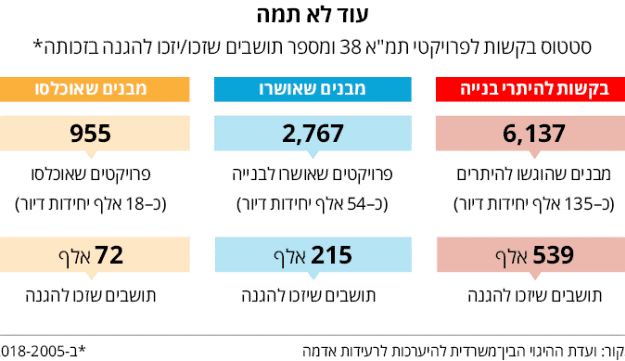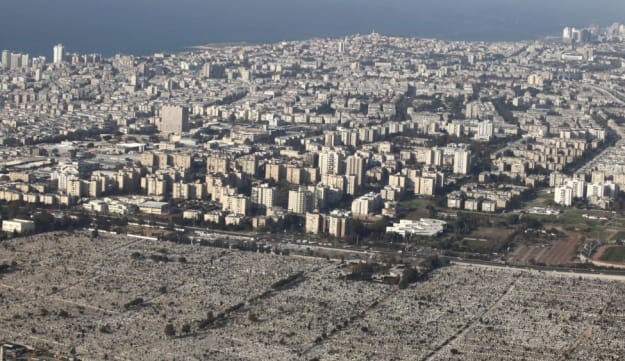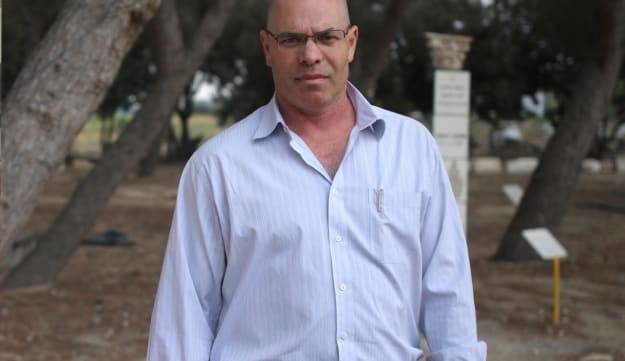Yael Derael, themarker.com
The fate of the 38-the national outline of earthquakes – was decided in a discussion that took place last week in the planning institutions and determined that the program would end in three years, in October 2022. Most of the arguments to the end of the program have touched planning considerations and to discuss its effectiveness in the renewal of the city's textures. However, an official document that came to the marker reveals that the state of Israel is exposed to a strong earthquake--with a power of 7.5-7 on the Richter scale – which is expected to strike at any moment in the Dead Sea area and to expose large parts of the country to injuries to the soul – most of them in the central region.
These estimates are exposed in a letter that was sent about two days after that, Amir Yahav, director of the Inter-Ministerial Steering Committee for earthquake preparations, to the head of housing at the Ministry of Finance, Zeev Bilski, and the CEO of the Planning administration, Dalit Zilber.
"In the studies of the Inter-Office Steering Committee, together with the Geological Institute, following a copy of the Dead Sea (fracture) behavior, which were presented to the Welsh members (the Committee on Planning-principle issues) in a discussion on October 22, we clearly see that in large parts of the Dead Sea we have already accumulated energy Which will be releasedin a very strong earthquake that evaluates to 7.5-7 on the Richter scale. Such a quake is expected to severely harm large portions of Israel, "Yahav".

The Inter-ministerial Committee was established following the earthquake that occurred on 1999 in Turkey, as a result of the decision of the Ministerial committee appointed by the government in August 1999. The Steering Committee is members of 40 representatives of government ministries, the Home Front command, emergency bodies, research institutes and civil organizations.
Although Yahav does not provide estimates of the time range in which Israel may command an earthquake with such intensity, it emphasizes that "a strong earthquake can occur at any moment". In this letter, it was noted that the risk of structures in such a quake stems mainly from the engineering condition, and that structures that are not durable and have not yet been strengthened – even if they are located in the region of the central country far from the Dead Sea, are liable to damage the earthquake in the scenario of a very strong quake.
According to the ranking of earthquakes in the Richter scale, earthquakes in ranges of 7.9-7 can cause severe damage in areas that are also far further away from the noise center.
"An estimate of 80 thousand non-durable structures (from earthquakes), most of which are located in the center, in areas where the day of 38 is implemented . The 36 thousand buildings located in the periphery approved a dedicated budget of NIS 5 billion to strengthen earthquakes and anti-missile and rocket protection, "said Yahav in his letter.
 Tel Aviv Metropolitan Area. "Out of some 80,000 buildings at risk, most of them are in the Gush Dan area
Tel Aviv Metropolitan Area. "Out of some 80,000 buildings at risk, most of them are in the Gush Dan area
Apocalypse Now
According to the information of the Inter-Office Steering Committee, throughout the years of Operation 38 to the end of 2018, they were submitted to the planning institutions for building permits that include about the 134 thousand housing units that would be strengthened from earthquakes in this route. According to the data, the number of residents who are to be protected from earthquakes due to the 38 projects is about half a million Israelis (about 540 thousand).
It should be noted in this context that in recent years criticized the effectiveness of 38, especially in the course of thickening and strengthening the structure, with regard to earthquakes. According to Yigal Govrin, chairman of the Engineers ' Association for construction and infrastructures, "GDP 38/1 limited effectiveness. The challenge of strengthening an existing building is the eruv of old and new, and strengthening the new structure from earthquakes, all when there is no reliable information regarding the structure of the building and its foundations in individual form.
According to him, "when there is an old building that wants to take care of it, there are two problems: one stems from the fact that a new part is added – it is in itself complicated, light and material when the old structure of the new building is inserted, and then it is still treated from earthquakes." All these when there is no reliable information about the old structure – not on the skeleton and certainly not on the foundations.
Officials in the yeshiva's planning institutions noted that Yahav was warned during the hearing that earthquakes are not necessarily expected to harm the settlements located along the Syrian rift rift, and presented a recommendation to allow the extension of 38 to five years, instead of only three years, as it finally decided.
Theonly policy tool that the Government has in order to minimize earthquake damage in residential buildings is 38, which has been supported for the last two and a half years in a dedicated Israeli standard. The Government understands that if it does not work for the strengthening of approximately 80 thousand residential structures that were built before the entry of the building standard, the state may be involved After an earthquake, with thousands of fatalities, tens of thousands of wounded and hundreds of thousands of people who were homeless, who would need the state to support, wrote Yahav.
 Amir Yahav, Director of the Inter-ministerial Steering Committee for Earthquake Preparedness
Amir Yahav, Director of the Inter-ministerial Steering Committee for Earthquake Preparedness
Yahav does not save in difficult scenarios, which include not only grave injury to the soul, but also significant budgetary cost. "Such a catastrophe may bring Israel back decades," he writes. He criticized the roadmap for which he had been agreed on in the Volnat yeshiva last week, in which it was agreed that the force would largely pass to local authorities. The new roadmap includes the transition instructions that will promote the planning administration to provide authority to the local committees to approve a detailed plan in the courts where there are structures that are charged with strengthening – for demolition and reconstruction.
The mayors will determine
The new bill which is expected to form and advance after the establishment of a new government will seek to delegate powers to the hands of the mayors and is likely to include authority for local committees to approve the urban renewal programs involving commercial and public uses. This means that the law will define the extent of the maximum construction in a given area, while the local committee will be given the discretion to decide on the distribution of uses, expansion of roads and public areas, and the unification of plots – which cannot be done today.
However, Yahav is noted in this context that "with the elimination of the 38, the subject will be completely in the hands of the local planning and building committees, which have other considerations that may sometimes prevail in the need to strengthen the structures for an earthquake." An example of this can be seen by a HCJ ruling against the Ramat Gan Municipality's position, in which the JDC enforced the government's policy and determined that the municipality of Ramat Gan would enable the implementation of 38 according to the policy established by the government.
"The proposal of the planning administration is almost completely and drastically neutralizes the ability of the Government's policy to strengthen buildings to save lives, leaving the decision to be made by the local planning committees only."
The planning Administration stated in response: "The data proves that the 38 does not give a real response to the treatment of strengthening structures against earthquakes, even in risk zones." Even in the aspect of urban renewal, the GDP has not responded to the total needs of the services required for a resident. The transition from a nationwide outline plan to programs that are being described on an entire residential complex will increase the certainty and realization of the various projects while improving the quality of planning.



